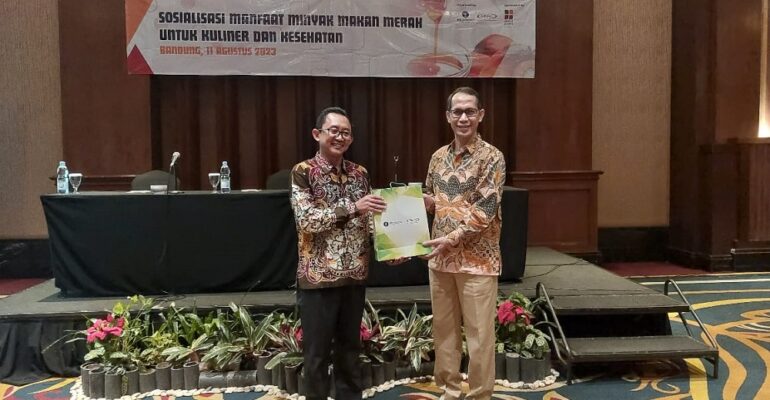SBRC IPB University Together with BPDPKS, Socialize the Benefits of Red Edible Oil, Good for Health and Stunting Prevention

The Surfactant and Bioenergy Research Center (SBRC) IPB University, together with the Palm Oil Fund Management Agency (BPDPKS), held a Socialization of the Benefits of Red Edible Oil for Culinary and Health (11/8) in Bandung. This activity is an effort to educate and straighten public perceptions related to red edible oil.
“The perception of good cooking oil in society is clear oil. In fact, red edible oil contains various important nutrients such as Vitamin A, Vitamin E, and beta-carotene, which are still high. Red edible oil is also relevant to the government’s short-term policy in 2024 to reduce stunting,” said Helmi Muhansah, Chair of the Small, Medium, and Cooperative Enterprises (UKMK) Division of BPDPKS.
Helmi explained that this activity is one of BPDPKS’ efforts to socialize and promote the goodness of palm oil in the face of negative campaigns against Indonesian palm oil. The processing of palm oil into red edible oil will support the increase in the added value of palm oil that can be directly benefited, especially at the palm oil farmer level.
“Red edible oil is one of the research products that has the potential to be commercialized. The UKMK Division of BPDPKS is ready to provide support so that red edible oil can be benefited by the wider community,” he added.
Chair of SBRC IPB University, Dr Meika Syahbana Rusli, said that red palm oil processing is a solution to improve the welfare of oil palm farmers and support the circular economy program planned by the government. He said that around 42 percent of palm oil production in Indonesia is produced on smallholder oil palm plantations. So far, fresh fruit bunches (FFB) from plantations have been forwarded to crude palm oil (CPO) mills, so the added value of palm oil is still predominantly enjoyed by large companies.
“The process of processing palm oil into red edible oil can be carried out at a smaller processing capacity, so that it is affordable for palm oil farmers and can be sold directly. This socialization is expected to be able to open up potential opportunities for the use of red edible oil for various processed products,” added Dr Meika.
Things to consider when consuming are how to keep the content of carotene and other phytonutrients maintained during processing. It can be done by preventing overheating.
BPDPKS plays a role in managing CPO export levy funds to support the Indonesian palm oil sector. This fund is then returned to the community, one of which is in the form of research funds for Palm Oil Research Grants. The aim is to support sustainable palm oil and good palm oil promotion activities, such as this red edible oil socialization activity.
In closing, Dr Tatang Hernas Soerawidjaja, BPDPKS Research Committee, also gave his opinion. “So far, palm oil refining has been carried out by removing its red color or beta carotene pigment. However, after purification, fortification is required with vitamin A, which is still imported, ” he said.
In fact, still according to Dr Tatang, beta-carotene can be broken down by the body into two vitamin A molecules, which are very important in the prevention of various diseases such as visual impairment and stunting.
“The potential isolation of beta-carotene itself from CPO is enormous. This happened before the biodiesel process was carried out, considering that the amount of CPO that reached 10 million tons is currently converted into biodiesel,” he said. (*/Rz) (IAAS/MZS)



